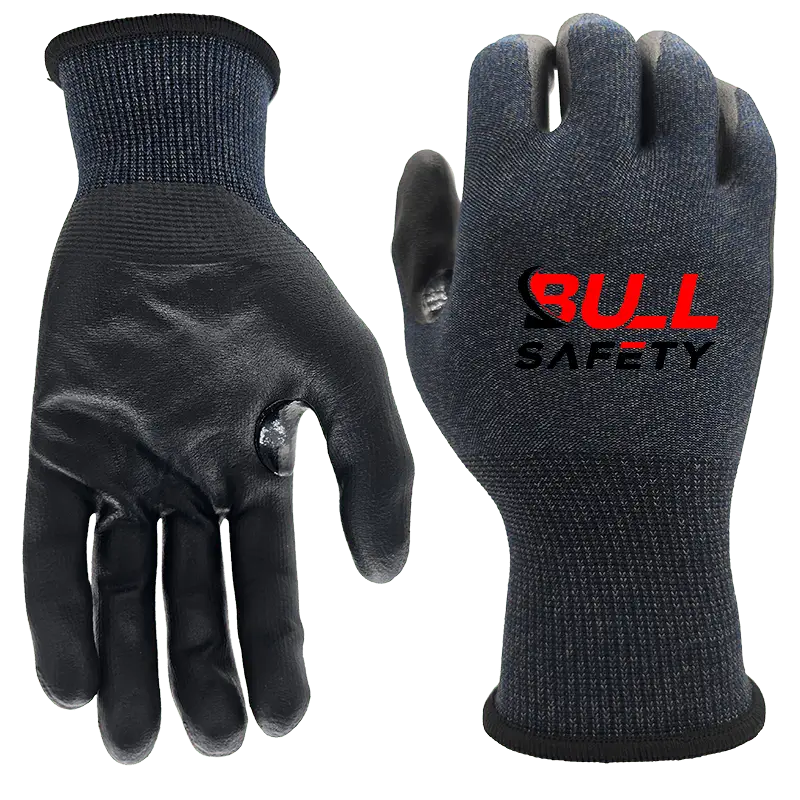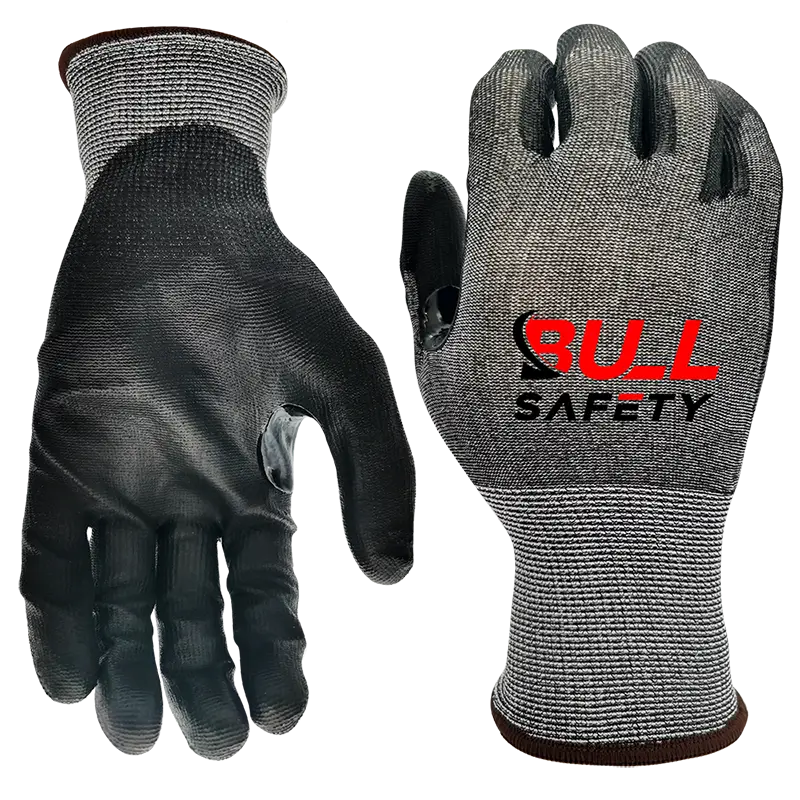Lately, more people are looking for gloves that do more than just protect. Have you wondered if your regular cut resistant gloves are enough for your daily work?
Graphene gloves offer superior cut protection, enhanced abrasion resistance, and antibacterial properties, making them safer and more comfortable than traditional gloves. They also help regulate sweat and heat, promoting a healthier and more comfortable work environment.
Many customers ask me, “Why should I switch from regular gloves to graphene ones?” If you’re a PPE wholesaler1, procurement manager2, or business owner, you’ll want to know why graphene gloves3 are quickly becoming the smart choice. Let’s break down what makes them special and learn how to choose the right pair for your team.
What are graphene gloves?
Some glove users think cut resistant gloves are all the same, but are you getting all the benefits you could from today’s new materials?
Graphene gloves are protective gloves made from advanced carbon material, offering enhanced cut resistance, abrasion protection, and antibacterial properties. They provide superior durability, safety, and cleanliness compared to regular gloves.
Many users only look at the highest number but miss out on newer materials that bring other benefits. Graphene is a thin sheet of carbon, just one atom thick, but it is stronger than steel and better at conducting heat than copper. Glove makers blend graphene into yarns to improve the gloves’ performance. Here’s why that matters:
- Cut resistance4: These gloves can reach the highest standards—EN 388 (A-F) and ANSI (A1-A9)—without needing steel or fiberglass. This means less irritation for users with sensitive skin, and no risk of tiny metal splinters.
- Abrasion resistance: Graphene5 makes fibers tougher and longer-wearing, so gloves last longer under heavy use.
- Antibacterial properties6: Graphene disrupts bacteria growth. Hands are cleaner and less likely to develop unpleasant odors or skin issues.
- Thermal/sweat control: Graphene absorbs heat and sweat fast, so hands don’t get as hot or uncomfortable. For many of my clients, this extra comfort makes a real difference in worker satisfaction on long shifts.
Here’s a quick comparison for context:
| Feature | Regular Cut Resistant | Graphene Gloves |
|---|---|---|
| Cut Resistance | Medium-High (A1-A6) | Very High (up to A9) |
| Abrasion Resistance | Medium | High |
| Antibacterial | No | Yes |
| Sweat Absorption | Low | High |
| Comfort | Standard | Excellent |
How to choose graphene gloves?
With so many gloves on the market, it’s easy to feel lost. How do you know which graphene gloves are right for your job or business?
When choosing graphene gloves, consider the cut and abrasion protection based on your work risks. Verify that the gloves meet safety standards for protection and hygiene, and test samples to ensure they offer the right comfort and performance for your team.
When I first selected our BOS Fifty graphene gloves for BullSafety, I focused on understanding client needs in different industries—like assembly lines, food processing, and heavy metal work. What mattered wasn’t just “highest cut level,” but choosing gloves that fit the work.
Follow these practical steps:
- Define tasks: List out the biggest risks and key needs—cut, abrasion, oil, grip, or temperature.
- Check standards: Reliable gloves must meet EN 3887 or ANSI standards, and clearly label their protection level.
- Material blend: Look for graphene fiber8 blended with strong base yarns (like HPPE). Make sure no steel wire if end users have allergies.
- Test comfort: Get samples and have real workers wear them for a shift. Pay attention to sweat, hand movement, and overheating.
- Check durability: Gloves take a beating. Choose models with high abrasion-resistance9, so you get longer life and better value.
- Hygiene needs: For food or sensitive settings, pick only gloves with antibacterial certifications.
- Supplier trust: Always buy from glove specialists who offer sample testing, and can provide compliance certificates.
Here’s a simple checklist table for buyers:
| Step | What to Check | Best Result |
|---|---|---|
| Risk Level | Match cut/abrasion standards | As per job needs (A2-A9 / Level 4) |
| Materials | Graphene + HPPE, avoid steel if allergies | Yes |
| Comfort | Try in real work, note sweat/fit | No discomfort/clamminess |
| Hygiene | Antibacterial property needed? | Certified by labs |
| Value | How long glove lasts per use | More wear cycles = better value |
Always remember—you want real-world proof, not just a pretty label.
The difference between graphene gloves and normal cut resistant gloves?
Do regular cut resistant gloves really stand up to new risks in the workplace as well as graphene gloves?
Graphene gloves provide superior cut and abrasion resistance, are lighter, and offer better hygiene compared to regular cut-resistant gloves. Their unique fiber structure makes them more reliable and comfortable for modern work environments.
![graphene vs regular cut gloves]
18g A3 foam nitrile palm coated graphene gloves bullsafety

Bullsafety 18gauge A4 4X43D PU palm coated cut resistant gloves
I used to think all cut resistant gloves were about the same if they had the right standard level. Yet, repeated testing and worker feedback showed clear gaps between “regular” yarns and graphene yarns.
Here’s a closer look at the differences:
- Protection mechanism: Regular gloves rely on glass fiber or steel wire to resist blades. These fibers can break, poke through the lining, or make users itchy. Graphene gloves use a super-strong single-atom lattice. No shards, no itching.
- Wear and tear: After just a few days of use, glass or steel fiber gloves showed loose threads and wear marks. The abrasion resistance of graphene, especially under tough work, stops this sort of early failure.
- Hygiene: Over time, regular gloves start to smell. This comes from moisture and bacteria. The antibacterial activity10 in graphene keeps gloves smelling fresh for longer.
- Comfort: Many users say that graphene gloves are less hot, sweaty, and itchy than regular gloves, especially for long wear. Improved sweat control means happier workers—and fewer requests for replacements.
Here’s the bottom line, displayed in a side-by-side table:
| Regular Cut Resistant Gloves | Graphene Gloves | |
|---|---|---|
| Cut Protection | Good | Excellent |
| Abrasion | Moderate | Very High |
| Antibacterial | No | Yes |
| Comfort/Sweat | Lower | Much Higher |
| Suitability | Standard | Most demanding jobs |
If you’re serious about preventing injuries, keeping costs steady, and giving workers gloves they want to wear, graphene is quickly becoming the better pick.
Conclusion
Graphene gloves outperform regular cut resistant gloves in protection, comfort, and hygiene, making them a smart investment for businesses that value safety and user satisfaction.
-
Understanding the role of PPE wholesalers can help you appreciate the supply chain and the importance of quality safety equipment. ↩
-
Learn about the critical role of procurement managers in sourcing quality materials and ensuring cost-effectiveness for businesses. ↩
-
Discover the unique advantages of graphene gloves, including durability and comfort, that make them a superior choice for safety gear. ↩
-
Understanding cut resistance in gloves can help you choose the right protective gear for safety and comfort in various tasks. ↩
-
Exploring the benefits of graphene can reveal its revolutionary impact on various industries, including safety gear and electronics. ↩
-
Discovering graphene’s antibacterial properties can enhance your knowledge of hygiene and health benefits in everyday products. ↩
-
Understanding EN 388 standards is crucial for ensuring the gloves you choose provide the necessary protection and meet safety regulations. ↩
-
Exploring the advantages of graphene fiber can help you make informed decisions about glove materials that enhance performance and comfort. ↩
-
Learning about abrasion-resistance will guide you in selecting durable gloves that offer better value and longevity for your needs. ↩
-
Learn how antibacterial properties in gloves can enhance hygiene and comfort, making them a better choice for daily use. ↩



